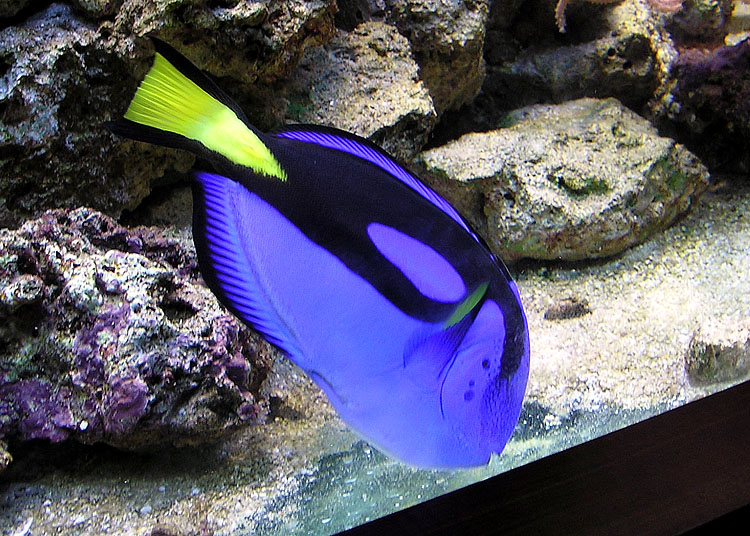|
| Query: Grouper | Result: 316th of 318 | |
Blue Tang (Paracanthurus hepatus) - Wiki
| Subject: | Blue Tang (Paracanthurus hepatus) - Wiki
| |

| Resolution: 750x536
File Size: 185252 Bytes
Date: 2004:09:05 13:39:30
Camera: C750UZ (OLYMPUS CORPORATION)
F number: f/2.8
Exposure: 10/400 sec
Focal Length: 63/10
Upload Date: 2007:01:05 23:28:29
|
Paracanthurus hepatus
From Wikipedia, the free encyclopedia
[Photo] Regal Tang fish at Bristol Zoo, Bristol, England. Taken by Adrian Pingstone in September 2004 and released to the public domain.
The blue tang, palette surgeonfish, regal tang, hippo tang, Indo-Pacific tang, flagtail surgeonfish or blue surgeonfish, Paracanthurus hepatus, is a fish often found in marine aquaria, the only member of the genus Paracanthurus. It has a royal blue body, yellow tail, and black 'palette' design. It grows to a maximum of generally 12.25 inches and is mostly herbivorous. Its range varies widely and can be around the reefs of East Africa, Hawaii, Japan, Samoa, New Caledonia, and the Great Barrier Reef.
Habitat
Tangs are found in the Atlantic Ocean from New York and Bermuda to the Gulf of Mexico, south to Brazil. they are also abundant in Florida, Bahamas, and the Caribbean Sea. In the eastern Atlantic Ocean it occurs near Ascension Island.
In coral reefs, blue tangs live in holes and crevices where they are sheltered from predators while they sleep at night. The blue tang lives singly, in pairs, or in small groups of up to 10 or 12 individuals, although occasionally it forms large aggregations that forage about the shallow reefs, grazing on algae. These aggregations sometimes include doctorfish (Acanthurus chirurgus) and other surgeonfish. The juvenile blue tang is rarely seen on the reef due to its small size and need for constant cover from predators. The intermediate phase with the blue body and yellow tail is often observed on reefs while young adults are abundant everywhere on the reef.
Food
This fish feeds entirely on algae. It grazes algae from rocky areas and browses filamentous algae, thereby avoiding large quantities of calcareous materials. Other surgeonfishes have heavier-walled, gizzard-like stomachs, and are capable of handling ingested sand and other calcareous materials. Blue tangs are important in keeping algae populations under control, preventing algae from overgrowing and suffocating corals.
Reproduction
Spawning occurs during late afternoon and evening hours. This event is indicated by a change in color from a uniform dark blue to a pale blue anterior and dark blue posterior. Males aggressively court female members of the school, leading to a quick upward spawning rush toward the surface of the water during which eggs and sperm are released. The eggs are small, approximately 0.8mm in diameter. The eggs are pelagic, each containing a single droplet of oil for flotation. The fertilized eggs hatch in twenty-four hours, revealing small, translucent larvae with silvery abdomens and rudimentary caudal spines. The newly hatched larvae are referred to as acronurus because they were once thought to represent a separate genus of fish, Acronurus. The acronurus is diamond-shaped and laterally compressed, with a head shaped like a triangle. It has large eyes and prominent pectoral fins, and vertical ridges on the body. The dorsal fins, anal fins, and scales begin to develop when the acronurus reaches 2-6 mm in length. The caudal spine does not appear until the acronurus reaches about 13 mm in length. Late post-acronurus drift inshore, where they metamorphose into juveniles. The acronurus lose their silver color and turn brown, and their profiles become round. The prominent dorsal and anal spines that are characteristic of the acronurus reduce, and the snout elongates. Complete metamorphosis takes about a week, after which two-inch long juveniles settle onto the bottom of a suitable inshore habitat.
Predators
Tuna, bar jack, tiger grouper, and other large carnivorous fishes are known predators of the blue tang.
Importance to Humans
The blue tang is of minor commercial fisheries importance, however it is occasionally utilized as a bait fish. The flesh has a strong odor and is not highly prized. This fish may cause ciguaterra poisoning if consumed by humans. However, blue tangs are collected commercially for the aquarium trade. An unwary human who tries to handle the blue tang risks the chances of being badly cut by the caudal spine. These spines, on both sides of the caudal peduncle, are extended from the body when the fish becomes excited. The quick, thrashing sideways motion of the tail can produce deep wounds that result in swelling and discoloration, posing a high risk of infection. The pain can last for hours, until eventually subsiding into a dull ache. It is believed that some species of Acathurus have venom glands while others do not. The spines are used only as a method of protection against aggressors.
Conservation
The blue tang is currently not listed with the World Conservation Union (IUCN) Redlist and is considered to be in no immediate threat.
Trivia
A blue tang named Dory (voiced by Ellen DeGeneres) appeared in Pixar's animated feature Finding Nemo.
The blue tang - and all tangs - are not included in the Dory fish order Zeiformes, but rather the order Perciformes.
http://en.wikipedia.org/wiki/Paracanthurus_hepatus
| The text in this page is based on the copyrighted Wikipedia article shown in above URL. It is used under the GNU Free Documentation License. You may redistribute it, verbatim or modified, providing that you comply with the terms of the GFDL. |
|
Comments |
|---|
| | kyrajunae |
|
| awwwwwww dori i loved finding nemo a quotee from my fav song swimmin in the money come in find me? nemo i loved nemo |
| | dorynemo |
|
| i love this movie! thnkaz! for the infooooooooooo;] |
^o^
Animal Pictures Archive for smart phones
^o^
|
|
|

